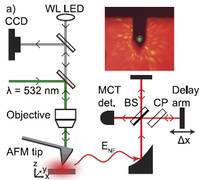Laser heating of scanning probe tips for thermal near-field spectroscopy and imaging
| Reviews and Highlights | Quantum Science | Molecular and Soft-matter | Ultrafast Nano-optics and Nanophotonics | Mineralogy and Geochemistry |
|---|
Brian T. O’Callahan and Markus B. Raschke
APL Photonics 2, 021301 (2016).
DOI PDF

Spectroscopy and microscopy of the thermal near-field yield valuable insight into the mechanisms of resonant near-field heat transfer and Casimir and Casimir-Polder forces, as well as providing nanoscale spatial resolution for infrared vibrational spectroscopy. A heated scanning probe tip brought close to a sample surface can excite and probe the thermal near-field. Typically, tip temperature control is provided by resistive heating of the tip cantilever. However, this requires specialized tips with limited temperature range and temporal response. By focusing laser radiation onto AFM cantilevers, we achieve heating up to ∼1800 K, with millisecond thermal response time. We demonstrate application to thermal infrared near-field spectroscopy (TINS) by acquiring near-field spectra of the vibrational resonances of silicon carbide, hexagonal boron nitride, and polytetrafluoroethylene. We discuss the thermal response as a function of the incident excitation laser power and model the dominant cooling contributions. Our results provide a basis for laser heating as a viable approach for TINS, nanoscale thermal transport measurements, and thermal desorption nano-spectroscopy.
